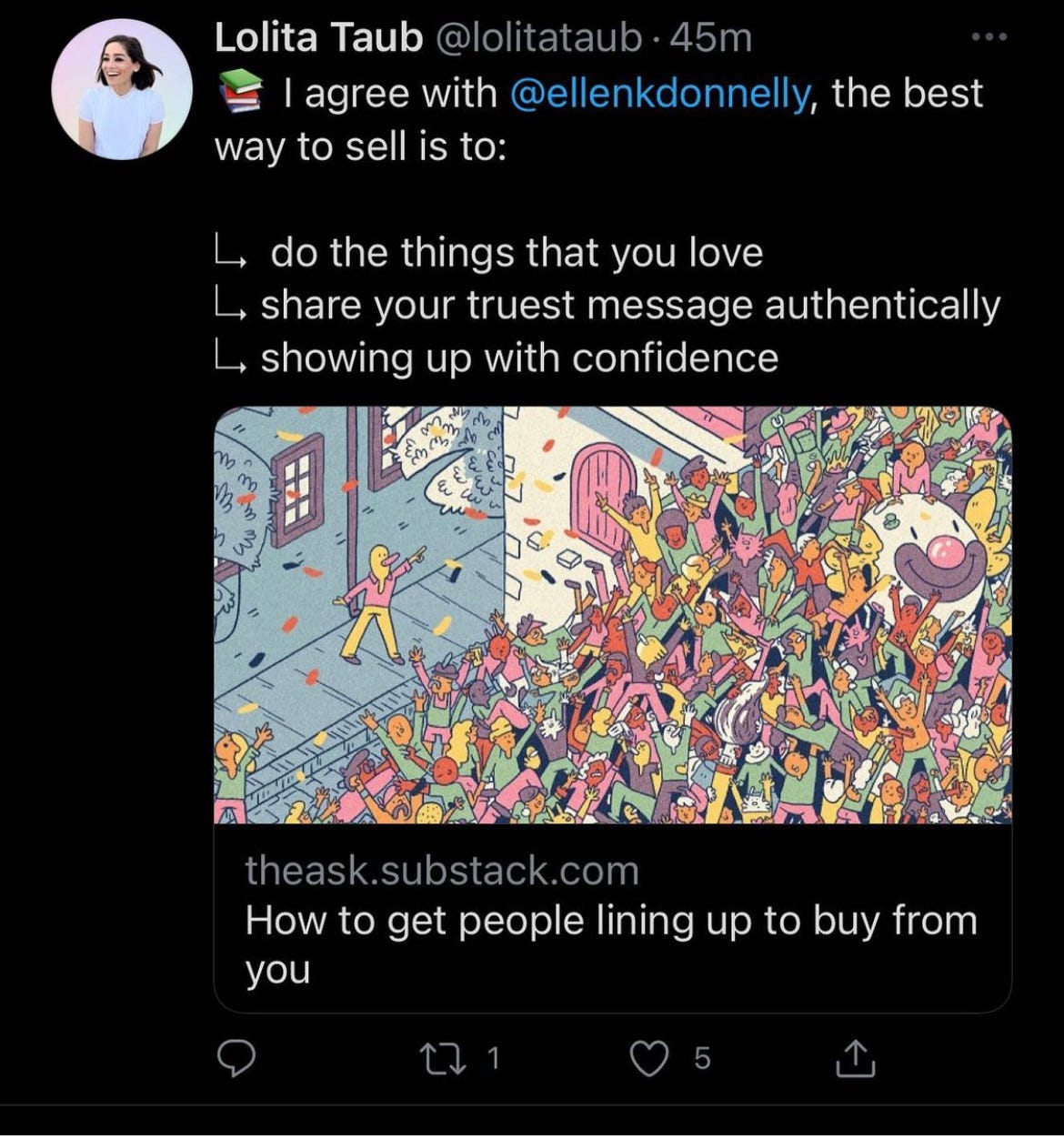Do you know what it takes to build a business in the right way?
The 7 steps to building a business that is both fulfilling AND successful. A wrap up of the company-building series from 2021 in this newsletter.
Quick question: How would you rate your knowledge on what it takes to build a business?
My guess is pretty high. This newsletter attracts real learners and curious minds and many of you are familiar with the concepts I write about, at least at a high level. I’ve been writing about company building since September so I hope you’ve picked up some new frameworks and knowledge.
But my real question for you today is not just how much you know inherently, but how much of the information have you actually acted on?
Because information is not transformation.
Knowing a thing and doing the thing are two different things. If they weren’t, then we’d not see so many people drink, smoke or overeat to an early grave. The reality is that we don’t often do what we know we should do.
So as I summarise the series in this post on what it takes to build a fulfilling business, rather than nod and ‘mhmm’ your way through… I want you to take action.
But - I hear you scream - you’re tired and ready for Christmas and need a break!
I know, same here.
But the only action you need to take for now is to grab a pen and paper, and score yourself for each of the seven steps. Simple. Give yourself a sad face if it needs some real attention, neutral face if you’re doing it ok and happy face if you’re doing it well.
And because to say thank you for your support this year, as a Christmas present and 2022 treat here’s something in return…
If you send me your list I will give you 30 min of coaching (for free) to work with you on the ‘sad’ areas in January. An offer for subscribers only whilst this email list remains a manageable size. I’d love to hear from you. Just yesterday in half an hour I coached a Founder of a beauty brand to generate four new actions to move her business forward, to which she said she felt clearer headed than she had in months.
So email me your results before the end of the year and the session is on me, no strings attached.
So back to the seven steps to building a fulfilling business… read on below.
Psst there is a part eight too (scaling, evolving, learning in your business) but its coming in 2022.
1. Use your strengths to determine which business build
Building a fulfilling business is the goal of entrepreneurship. A business that lights you up and one that you actually enjoy running. The way to arrive at this point is understand how you are wired — your key strengths and personality — then use this information to map to the right business for you. So that what you build comes more easily because of who you are.
I hammer this point home a lot in my work because this process is both what I do with my clients and it’s why I decided to be a coach (feeling unfulfilled in my previous career I figured out what was missing and built a business around my biggest strengths and interests instead).
The process of 'Effectual reasoning’ was coined by Wharton professor on entrepreneurship Ethan Mollick to describe this process of figuring out “Who are you? What do you know? And who do you know?” which he says is the key to designing the right business for you and matching that information to the needs of the world first and not the other way around. Which isn’t selfish, it just makes sense. His book The Unicorn Shadow goes into this and disputes some of the myths on being a successful founder.
Original posts on this theme: i) Using your strengths to decide on your business ii) More thoughts + profile with career coach Hannah Shtein
2. Find the time and money to build your business
Practically speaking, you have to figure out where the time and the money are going to come from to build your business.
If you’re stressing about these two points it won’t be very fulfilling.
Research shows that the majority of businesses are funded by the entrepreneur’s personal savings (Source). I built The Ask from a combination of my own savings and revenue from consulting for VC backed businesses and then funnelled the revenue back into my new business. Despite running a lean operation, I’ve incurred a whole hosts of costs to get started so I’ve needed all the money I could get my hands on. Oh and to sustain a mortgage and life at the same time.
There is a misconception in the world of online services businesses that we don’t need startup capital because there are no products to build or brick and mortar requirements to pay for. That’s wrong. You will have to invest in your business at some point in order to see returns. Invest in your training, development, some advertising, the right platforms, legals and more. I have spent £15k+ on coaching and mentoring alone to be where I am today.
So — where do you get this money from?
Whatever business you are building, unless you already have money readily available here, you will have to get creative. Funding can be secured once you have a working product or some results to show but until that point you may have to fund it yourself and that involves getting creative.
This might look like setting up a consulting/freelancing services arm that you can charge a retainer/day rate to deliver and use this income to build your new business, you might work part time for a company, or you might borrow money from family or the bank, or perhaps hustle together different projects. Work in a bar if you need to. If you want it enough, anything goes.
Know your personal runway and balance your time spent working on other projects with the time needed to build your business, be patient, and you will get there.
Original posts on this theme: i) How to find the time and money to start your business ii) More thoughts + profile with serial entrepreneur Shaun Gold.
3. Pursue a business mission in line with your personal ambition
Your '‘why’ for your business should determine the actions you will and won’t take.
Personal and business goals should align at each step of the way, however, this is easier said than done because being both the person who both sets the vision and executes on it at the same time will involves challenging decisions and trade offs.
We don’t always know fully what these are, so the temptation becomes to avoid making them at all.
Avoiding making these trade offs is a mistake because “a strategy that is so broadly stated that it permits a company to do anything is tantamount to no strategy at all” according to Amir Bhide in this HBR article The Questions Every Entrepreneur Must Answer.
These trade offs likely bring a fear of the wrong choice, or a trade off in time, money or energy. An obvious one: businesses that are significantly larger than the founder themselves will require risky long-term bets and deep pockets to fund. But smaller, lifestyle businesses based on the founder’ skills might get to profit quicker but prohibit the founder stepping away or being able to sell their business on. A client session this week saw this at face value: she wants to build a big business which allows her to step away and not do everything, but hiring someone to help do this means less money for her now.
Yet having a strategy aligned to your personal goals is key to create better decision making, focus on the right things, and better time management and execution.
Original posts on this theme: i) Pursuing a strategy based on personal goals ii) More thoughts + profile with business strategist Alex Smith
4. Design a business model based on what you, the market and your customers want.
Regardless of whether you raise money or fund your business yourself you will need revenue to keep it alive.
There are countless business models available to do this and the right choice of business model depends on you, largely, and some other key factors.
FYI a business model is i) How you will create your product/service e.g design and build and ii) how you will distribute it to customers e.g customer research, selling and marketing.
Here are your factors in this three part framework to decide on your business model:
Understanding your customers.
Knowing exactly who they are and what they need from you, this might be a previous version of yourself evenUnderstanding the market.
What can you feasibly charge, how are your competitors solving this already, is there enough demand etc.Understanding yourself.
To build on the earlier points, you have to know your strengths, vision for your life and what you can afford in terms of time and money to create.
Why you need all three:
If you have customer and market need but it is not matched to your own desires then you will feel unfulfilled and won’t enjoy your business.
If you have your needs and the customers sorted, but the market doesn’t fit, then you won’t turn a profit.
If you have market needs and your own but the customer doesn’t want it, then either you have the wrong customer or you have not positioned it correctly in terms of your messaging.
Each requires some work to make a clear decision and can be hard to analyse on your own sometimes so I often do this work with clients. For more reading check out:
Original posts on this theme: i) How should you design your business model ii) More thoughts + profile with Rick Koletavitoglu who has pivoted a business model multiple times.
5. Choose a niche for your business and market to the right people
A niche allows you to position your business with clarity and confidence. But choosing one can be so. damn. hard.
It is hard because as founders, we are ambitious and want to work on big problems. Niching requires getting really narrow and segmenting to certain people which is inherently discarding lots of potential buyers.
It also looks very different to the giants we see, companies like Amazon, Google, and Tesco creating and selling thousands of products to virtually everyone. Why can’t we?
Product marketing guru Alicia Carney told me that picking one problem to solve can feel like you’re shooting yourself in the foot or capping your opportunity as a founder, but in fact the key requirement is to be able to get ‘uncomfortably narrow’ and to start small.
My opinion is that niching is so key in business because it is basically a synonym for ‘stay focused’ and ‘get really good at what you do’. It resonated with Joyce Kettering on Twitter:
By having a niche, you are able to truly say that you have solved your ideal clients problem without doubt.
Because what is a business without a problem it is solving?
Once you have solved that problem in a sustainable and profitable way that gets results, then you can build more offers for more customers and essentially broaden your niche. Amazon started with books, remember.
You can try to build without a niche, but I can guarantee it will be harder. I’m learning that as I grow, I thought I was niche enough but still think I need to go more narrow for more results.
Whilst it could seem ambitious to want to take on more sooner I’ve seen that doing so may be an avoidance tactic. Business is hard. So when results don’t come overnight we can decide to look elsewhere for other avenues that may be easier.
But the reality is that every path represents opportunities and set backs and once you stay in your lane and commit, you will reach your goals that much sooner.
Original posts on this theme: i) Why is it so hard to pick a niche? ii) More thoughts and profile from Alicia Carney, product positioning expert
6. Promote your business effectively and get people lining up to work with you
Once you know who your product/service is for you need to get out there and persuade people to buy it. Whilst you probably wish they would come and find you on their own terms, that is rarely going to happen without a little push.
If the biggest brands in the world like Coca Cola need to do marketing and advertising then so do you.
How do you go about promoting your business? It can be the hardest part for many founders, and after nearly two years in the game, I know why.
Promotion is both an art and a science.
A science because there are tactics you can use that work — marketing agencies can charge so much because of their industry knowledge — but it is also an art because we don’t always know why something resonates so deeply with a customer. Why certain people grow audiences faster, or their work goes virtal, and others don’t.
What does seem to be true, however, is that promoting your business (or yourself if you are the service) will be an easier journey if you have these three parts down:
i) Doing the things that you love aka the promotional activities that come naturally and make sense for you to do
ii) Sharing your truest message authentically aka be bold enough to own your mission and values and what makes you unique
iii) Showing up with confidence aka do this frequently and with conviction about why your business needs to exist
If you hadn’t noticed I loveee a neat framework and I think this sums it up fairly well. The investor Lolita Taab discovered the original post and agreed, she even Tweeted it to her 54k followers:
Original posts on this theme: i) How to get people lining up to buy from you ii) More thoughts and profile from Daisy Morris, The Selfhood
7. Learn to lead yourself effectively
The last part is doing all of the above to get your business in line but then leading yourself too.
Leading yourself is about decision making, clear thinking, strong habits, routines and creating mental fortitude. It’s about doing the hard things, taking the right next step, courageous act or sending that email when you don’t feel like it.
It’s about learning your blind spots and overcoming them.
You could say coaching focuses on this step exclusively, but my coaching programmes include it all. Because if you’re not building a business that aligns to your strengths, the vision you have for your life, your interests or passions then leading yourself well - eg productivity hacks - can only take you so far.
Leading yourself effectively involves knowing how you are wired so you can forgive yourself if you’re not operating like a machine or waking at 5am each day in the name of ‘success’ and it involves being able to toggle between being your own biggest advocate and critic depending on what medicine you need.
How you do these things will be based on how well you know what you want, why you want it and what you need to do to get there.
It is these factors that influence how you build your business and the decisions that you make on the journey. It’s why ‘business coach’ doesn’t quite capture what I do as I believe you can only talk about these topics (strategy, goals, business model, promotion) through the lens of you as a person as you go through each process.
Practically, leading yourself well is about deliberate self-reflection and then making changes that need to happen as a result of what you learn. It’s about re-evaluating where you are going and why it matters and doing the hard things that ensure you get there.
These stages are somewhat sequential but that doesn’t mean you can’t go ‘back’ to a previous stage as you evolve.
In 2022 I’m reviewing my vision and product positioning in January, to ensure it is clear and focused. I know that you have to have these in place for everything else to work too — so its not the case that these things are static either. Sometimes you have to go ‘back’ a few steps so that you can move forward. Before you go — why not leave a comment with what is standing out for you the most of all these points.
Thanks as always for reading!
Next week I’ll send you some reading and ideas to end the year but it will be very light touch before wrapping for the year!
Ellen Donnelly, Founder + Chief Coach, The Ask.







